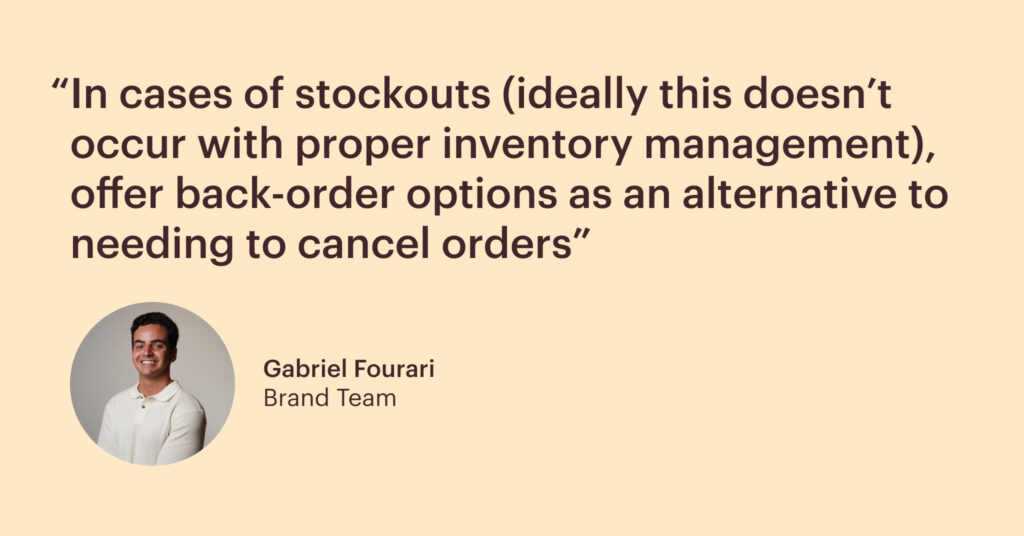

After a busy buying season, retailers can be flooded with new brands and products. So, what makes them come back to yours? Often, it’s not just what you sell – but the ease and care of the experience you deliver.
On Faire, great customer service doesn’t just improve your relationships – it boosts your visibility, strengthens your reviews and leads directly to more reorders. The best part? It doesn’t require big investments. Just thoughtful, consistent actions that show retailers you care and meet expectations.
We pulled insights from Faire’s Customer Service analytics and Faire’s own brand team to highlight the core service behaviour that set top-performing brands apart and keep them on track for success.

1. Respond quickly and clearly
Faire retailers expect fast, helpful communication. A timely response to product questions or order updates can build immediate trust – and help retailers feel confident placing that second (or fifth) order.
“Stay on top of inbound messages. Using push notifications and in-app alerts [on the Faire app] help brands stay updated on any new messages.” – Gabriel
Using messaging as a way to keep your customers informed of shipping details and order changes, or even to follow up post-order to see how they like the product, can go a long way.
Why it matters: Customers who get a quick reply are 45% more likely to place a first order. To stay on track for your messaging expectations, reply within two working days maximum. Your response time is a tracked metric in Faire’s Customer Service analytics and can affect how often your brand appears in search and recommended sections.
Pro tip: Use the Faire app to stay on top of messages, especially during high-volume sales periods and while you’re on the go – removing the burden of having to be at a desktop to drive results.
2. Set realistic lead times – and honour them
Shipping late is one of the fastest ways to lose retailer trust – and we know it’s not always in your control. If your team are running behind or if schedules shift, update your lead time so buyers have clear expectations. When it comes to lead times, accurate is better than aspirational.

“Lead-time hygiene is a big focus area. Adjust your lead times as needed if you feel like there are thematic delays in your shipping flow that aren’t necessarily typical for you. Brands tend to think our lead times are static, [but you can] update them as needed, as we know there are circumstances and/or seasons where you don’t have as much control.”
– Lisa
Why it matters: Late shipments can hurt your fulfilment score, reduce your visibility on Faire, and impact your reviews – especially those related to fulfilment and communication.
Pro tip: In your Shop Settings, revisit your Shop lead time regularly to keep it accurate. This small habit protects your service metrics and ensures retailers get a reliable experience.
3. Ask for reviews with care
Retailers trust peer feedback. A glowing review is often what tips the scale for a new buyer – and reinforces loyalty for repeat ones. And the best reviews come when you ask with care – like a handwritten note, a QR code on the packing slip or a friendly follow-up message.
Create a segment showing retailers who’ve placed three-plus orders without a review, then email them thanking them for their loyalty and asking if they’d be willing to leave a review – sometimes [I recommend] adding a promo code for their next order.
Lizzy
Why it matters: Positive, timely reviews build trust and confidence for other retailers browsing your shop. On Faire, retailers are prompted to review both their overall order and individual products – giving you more chances to earn strong, detailed feedback. Plus, if you meet a 4.8 average, you’ll meet one of the criteria for Top Shop.
Pro tip: Use the “request a review” template available in Faire’s Messaging tool as a gentle nudge for reviews from your customers. You can also include the printed packing slip with the QR code for a review in your shipment or offer a small promo code for their next order – and always thank them personally.
4. Resolve fulfilment friction before it becomes a pattern
Even a single damaged shipment or out-of-stock cancellation can chip away at retailer trust. The brands that grow fast on Faire are the ones that proactively fix recurring issues – especially around packaging and stock. To make things even more seamless, make sure you take advantage of easy-to-use integrations that help synchronise your inventory across channels, like Shopify.

Why it matters: Repeated fulfilment issues lower your service performance and can increase churn – plus, in the case of damaged items, it impacts your sellable stock.
Pro tip: Review order issues in Customer Service analytics and look for trends. Small adjustments can have a big impact.
5. Use your team to scale better service
As your order volume grows, so do the service touchpoints that need attention. Inviting team members to your Faire portal and assigning clear roles helps ensure nothing slips through the cracks – keeping retailers happy and orders on track.
Why it matters: When more of your team can see and support your Faire customers, service improves. Brands that add team members to their account on Faire see up to 30% lower late shipments and late replies to retailer messages.*
Pro tip: Add team members to your Faire portal so fulfilment, messaging and order management can happen in parallel – without bottlenecks.
Customer service is more than a good habit – it’s a growth strategy
Your Faire shop is always open, and the service you provide is always shaping how retailers experience your brand. By responding quickly, setting clear expectations and learning from trends, you create the kind of experience retailers want to return to again and again.
Review your Customer Service analytics today – and turn small improvements into long-term loyalty.
*Data compares multi-user adopters to non-adopters, controlling for brand attributes like number of stockists and geography. Customer service metrics were measured before and after multi-user adoption (Aug 2024 vs March 2025) to assess changes over time.




